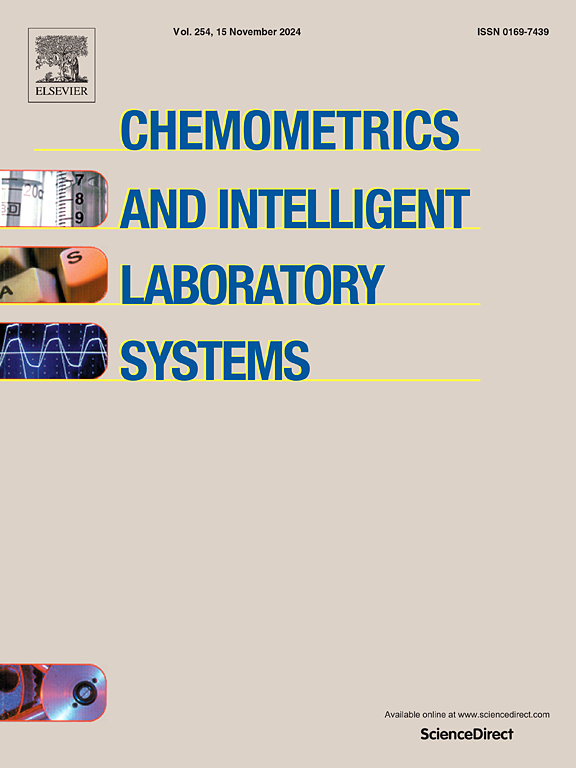Marker genes identification and prediction of Parkinson's disease by integrating blood-based multi-omics data
IF 3.8
2区 化学
Q2 AUTOMATION & CONTROL SYSTEMS
Chemometrics and Intelligent Laboratory Systems
Pub Date : 2025-07-04
DOI:10.1016/j.chemolab.2025.105478
引用次数: 0
Abstract
Parkinson's disease (PD) is a rapidly progressing neurodegenerative disease marked by a combination of motor and non-motor symptoms. The molecular mechanism of PD remains unexplained, and there is currently no genetic risk factor with clinically proven reliability. Therefore, diagnosing PD has relied chiefly on analyzing brain images and clinical tests. Understanding the molecular-level mechanism of PD is challenging, primarily due to the complexities involved in sampling the posterior brains of both typical individuals and those with PD; however, several independent research have recently produced and assessed extensive omics data obtained from blood samples, making the diagnosis cheap and less invasive. Therefore, developing diagnostic or predictive methods for PD utilizing these data is necessary. In addition, integrating omics data can serve as a valuable asset for a comprehensive understanding of the disease. This research devised a computational approach to predict PD by integrating gene expression and DNA methylation datasets. The significant challenges were the high dimensionality and heterogeneous data sources. A two-level statistical approach is proposed to identify Differentially expressed and Methylated Genes. Archimedes Optimization Algorithm, a meta-heuristic algorithm, selects 17 optimal genes and 18 mapping CpG sites. A clustering-based method is proposed to integrate the heterogeneous omics data. Predictions of PD and healthy samples are performed using the Tabnet classification model. The proposed approach demonstrated an ROC-AUC of 0.7615 and an F1-score of 0.7325 on test data. The significance of our work is supported by biological analysis and assessment metrics.
整合基于血液的多组学数据的帕金森病标记基因鉴定和预测
帕金森病(PD)是一种进展迅速的神经退行性疾病,其特征是运动和非运动症状的结合。PD的分子机制尚不清楚,目前尚无临床证实可靠的遗传危险因素。因此,帕金森病的诊断主要依靠分析脑图像和临床检查。了解PD的分子水平机制是具有挑战性的,主要是由于典型个体和PD患者的后脑采样涉及的复杂性;然而,几项独立研究最近产生并评估了从血液样本中获得的广泛组学数据,使诊断成本低且侵入性小。因此,利用这些数据开发PD的诊断或预测方法是必要的。此外,整合组学数据可以作为全面了解疾病的宝贵资产。本研究设计了一种通过整合基因表达和DNA甲基化数据集来预测帕金森病的计算方法。最大的挑战是高维和异构数据源。提出了一种两水平统计方法来识别差异表达和甲基化基因。阿基米德优化算法是一种元启发式算法,选择了17个最优基因和18个CpG定位位点。提出了一种基于聚类的异构组学数据集成方法。PD和健康样本的预测使用Tabnet分类模型进行。该方法在测试数据上的ROC-AUC为0.7615,f1分数为0.7325。我们工作的重要性得到了生物学分析和评估指标的支持。
本文章由计算机程序翻译,如有差异,请以英文原文为准。
求助全文
约1分钟内获得全文
求助全文
来源期刊
CiteScore
7.50
自引率
7.70%
发文量
169
审稿时长
3.4 months
期刊介绍:
Chemometrics and Intelligent Laboratory Systems publishes original research papers, short communications, reviews, tutorials and Original Software Publications reporting on development of novel statistical, mathematical, or computer techniques in Chemistry and related disciplines.
Chemometrics is the chemical discipline that uses mathematical and statistical methods to design or select optimal procedures and experiments, and to provide maximum chemical information by analysing chemical data.
The journal deals with the following topics:
1) Development of new statistical, mathematical and chemometrical methods for Chemistry and related fields (Environmental Chemistry, Biochemistry, Toxicology, System Biology, -Omics, etc.)
2) Novel applications of chemometrics to all branches of Chemistry and related fields (typical domains of interest are: process data analysis, experimental design, data mining, signal processing, supervised modelling, decision making, robust statistics, mixture analysis, multivariate calibration etc.) Routine applications of established chemometrical techniques will not be considered.
3) Development of new software that provides novel tools or truly advances the use of chemometrical methods.
4) Well characterized data sets to test performance for the new methods and software.
The journal complies with International Committee of Medical Journal Editors'' Uniform requirements for manuscripts.

 求助内容:
求助内容: 应助结果提醒方式:
应助结果提醒方式:


